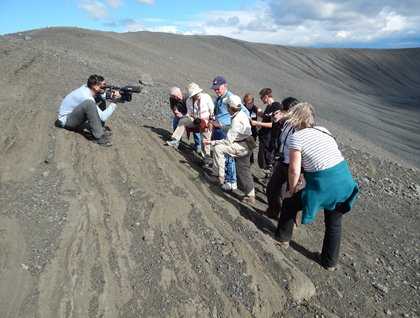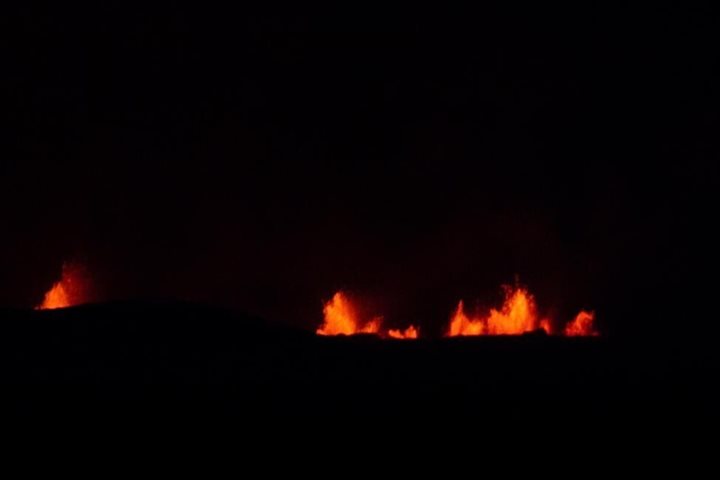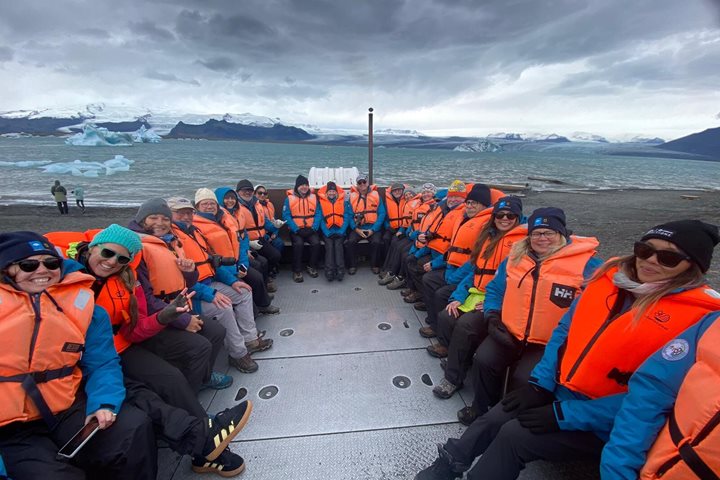“I feel emotional landscapes.” Bjork “Joga” Homogenic
After several days exploring sights close to the sea, we spent much of today further inland. Beginning in Akureyri and ending in Husavik, we travelled by bus to visit several of Iceland’s unique geological features. Hverfjall and Viti volcanos, Dimmuborgir lava sculptures, Namaskard boiling mud springs, Godafoss waterfall and Myvatn minerals baths were the main attractions of the day. Lush, rolling landscape, barren lava fields, and higher, snow-capped peaks in the distance gave us a new perspective on this island country as we travelled between sights. Evening found us relishing the midnight sun from the cliffs of Grimsey Island on the Arctic Circle.
Straddling the Mid-Atlantic Ridge over the spreading North American and Eurasian plates, Iceland was and continues to be shaped by continuous geologic activity. While many of us may envision volcanic eruptions as a mountain exploding, spewing lava and ash, the Hverfjall Volcano has a different story. Geologists have traced its origins back to magma that rose up from below the earth's surface to emerge under a lake. When water and molten rock collide it produces steam that expands from one cubic meter to 1600 cubic meters instantaneously! The result – BOOM, BOOM, BOOM! Explosion after explosion sent steam and lava into the sky, forming layers of cooling rock and ash that created a low, wide cone-shaped crater. In the middle, the last blast left one final feature, a smaller hill of tephra rock on the crater's floor. Looking down from the rim of the crater to the scene beyond littered with pseudo-craters, steam vents, and the lush ecosystem that has rebuilt itself, one couldn't help but feel awestruck by the incredible power of our earth to create and destroy.
While climbing the crater, stepping across the continental plates, and standing in the path of the billowing steam produced by bubbling mud pits, one cannot help but be humbled by the profoundness of this place. Not only is Iceland’s geology among the richest in the world, but it is also notable for its inspirational landscapes. Turn away from the crater or the mud pits, and one will be met by vistas of undulating green tundra, glistening lakes, and snow-capped mountains.
We concluded our day on Grimsey Island, which rests on the Arctic Circle. Taking our first steps into the Arctic, we were surrounded by thick green grass set alongside puffin-dotted cliffs that gaze into the sea. As surreal as a dream, thousands of Arctic terns, with their articulated wings, split tail feathers, and cacophony of noise, swooped near our heads, asserting their dominance and clarifying our status as visitors. Standing among these wonders, it became clear that the history and landscapes blanketing Iceland go beyond the scientific. They are personal. They are emotional. They command attention, presence, and gratitude.








